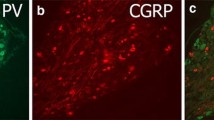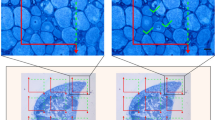Abstract.
The timecourse of cell death in adult dorsal root ganglia after peripheral axotomy has not been fully characterised. It is not clear whether neuronal death begins within 1 week of axotomy or continues beyond 2 months after axotomy. Similarly, neither the timecourse of satellite cell death in the adult, nor the effect of nerve repair has been described. L4 and L5 dorsal root ganglia were harvested at 1–14 days, 1–6 months after sciatic nerve division in the adult rat, in accordance with the Animals (Scientific Procedures) Act 1986. In separate groups the nerve was repaired either immediately or following a 1-week delay, and the ganglia were harvested 2 weeks after the initial transection. Microwave permeabilisation and triple staining enabled combined TUNEL staining, morphological examination and neuron counting by the stereological optical dissector technique. TUNEL-positive neurons, exhibiting a range of morphologies, were seen at all timepoints (peak 25 cells/group 2 weeks after axotomy) in axotomised ganglia only. TUNEL-positive satellite cell numbers peaked 2 months after axotomy and were more numerous in axotomised than control ganglia. L4 control ganglia contained 13,983 (SD 568) neurons and L5, 16,285 (SD 1,313). Neuron loss was greater in L5 than L4 axotomised ganglia, began at 1 week (15%, P=0.045) post-axotomy, reached 35% at 2 months (P<0.001) and was not significantly greater at 4 months or 6 months. Volume of axotomised ganglia fell to 19% of control by 6 months (P<0.001). In animals that underwent nerve repair, both the number of TUNEL-positive neurons and neuron loss were reduced. Immediate repair was more protective than repair after a 1-week delay. Thus TUNEL positivity precedes actual neuron loss, reflecting the time taken to complete cell death and elimination. Neuronal death begins within 1 day of peripheral axotomy, the majority occurs within the first 2 months, and limited death is still occurring at 6 months. Neuronal death is modulated by peripheral nerve repair and by its timing after axotomy. Secondary satellite cell death also occurs, peaking 2 months after axotomy. These results provide a logical framework for future research into neuronal and satellite cell death within the dorsal root ganglia and provide further insight into the process of axotomy induced neuronal death.
Similar content being viewed by others
Author information
Authors and Affiliations
Additional information
Electronic Publication
Rights and permissions
About this article
Cite this article
McKay Hart, A., Brannstrom, T., Wiberg, M. et al. Primary sensory neurons and satellite cells after peripheral axotomy in the adult rat. Exp Brain Res 142, 308–318 (2002). https://doi.org/10.1007/s00221-001-0929-0
Received:
Accepted:
Issue Date:
DOI: https://doi.org/10.1007/s00221-001-0929-0




